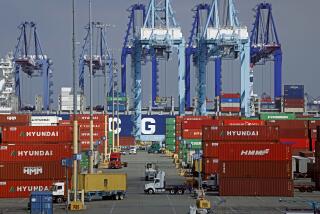VIEWPOINTS : Hopes for the Pacific Rim Are Bound to Be Dashed
- Share via
Fashionable ideas, such as the Pacific Rim becoming the new center of world economic activity, seem to float around the world as if they were the Asian flu.
In the Pacific Rim hypothesis, Japan, South Korea, China, Indonesia, Taiwan and the West Coast of the United States are supposed to be to the 21st Century what Europe and the East Coast of the United States were to the 20th Century. Often such ideas are most fashionable, however, just when they are about to become untrue.
As an illustration of the contagious nature of such ideas, the Pacific Rim hypothesis has become very fashionable in the Soviet Union, a country that Americans tend to forget has a very long Pacific shoreline. The Soviet Far East, the area east of a north-south line drawn through Lake Bikal, is after all much closer to Japan and China than any part of the United States.
Seminars are now being given in the Moscow think-tanks on the advisability of restructuring Soviet regional development.
The old strategy of development essentially calls for development to roll east from European Russia. Western Siberia would be developed first, then eastern Siberia and finally the Far East. Under the new strategy of development being discussed, development would leapfrog from the European part of the Soviet Union to the Soviet Far East, leaving Siberian development for a later period of time.
The Soviet Far East would become an export base serving the rapidly growing Pacific Rim and would be the location of many joint ventures with Western firms that are to be permitted under the new economic reforms. Far Eastern exports could replace the reduced earnings from oil exports in Europe and help pay for needed imports.
Major investments have been made to improve the transportation system of the Soviet Far East, and given the possibilities of coastal shipping, transportation is much less a problem in the Far East than it is in Siberia.
One can easily imagine a Soviet Far Eastern aluminum industry selling its output to Japan--a country that is a big user of aluminum but is shutting its industry down because of relatively high energy costs.
True Believers
While the Pacific region certainly will be more important economically in the 21st Century than it was in the 20th Century, on both sides of the Pacific it is easy to exaggerate its prospects.
Such changes usually occur much more slowly in reality than they do in the minds of true believers, and one can easily make an argument that the period of most rapid Pacific growth is behind us.
Japan has essentially reached parity with the United States in terms of per-capita gross national product, and Europe and its fast catch-up phase of economic growth is clearly behind it.
It is not going to grow as fast in the next 30 years as it did in the last three decades. This reversal is already under way. In the past five years, Japanese growth has been very modest compared to its previous performance.
The same might be said about California. Northern California is already showing some of the signs of industrial “old age.”
While South Korea and Taiwan may continue to grow rapidly, they both have relatively small populations. The same is true of the Soviet Far East--its population is only 5 million.
To have rapid economic growth in the region, the big countries--meaning China and Indonesia--must grow rapidly.
But Indonesia is hampered by its lack of educated, well-skilled workers--a labor pool that is an absolute prerequisite for rapid economic growth. China has a literate population, but it starts from a lot farther behind the competition in 1987 than the Japanese did in 1957.
History teaches us that those initial steps into semi-development are much slower and much harder to make than later steps from semi-development to rapid growth. It took South Korea and Taiwan about three decades to get into an economic orbit where they could sustain rapid economic growth.
Limit to Exports
Japan, South Korea and Taiwan also have been structured as export economies, and yet their exports cannot continue to grow in the future as they have in the past.
All these countries have achieved large export surpluses based on their trade with the United States. Such a situation cannot continue to exist. No country can forever run a trade deficit, since this implies an ability to become an infinite debtor. Eventually, any country must balance its exports and imports (with a falling dollar being the most likely route), and this will mean that exports from Japan, South Korea and Taiwan will begin to fall.
Falling exports may well lead to relative economic stagnation in Japan, South Korea and Taiwan, unless they are successful at restructuring themselves as domestic-powered economies.
Even if this is eventually done, it will take time to move from export industries to domestic industries, and during the transition, growth is apt to be slow. Japan is a current case in point. Its exports are stagnant, and this has produced a stagnant Japanese economy.
It does not take a lot of imagination to envision discussions five years from now as to why the expected growth in the Pacific Rim never occurred.
The Pacific Rim is here to stay, but it may have passed its peak as an intellectual fad.
More to Read
Sign up for Essential California
The most important California stories and recommendations in your inbox every morning.
You may occasionally receive promotional content from the Los Angeles Times.










